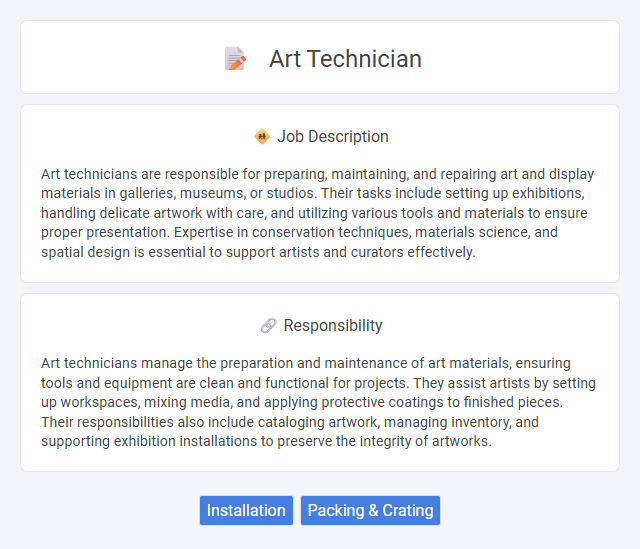
Art technicians are responsible for preparing, maintaining, and repairing art and display materials in galleries, museums, or studios. Their tasks include setting up exhibitions, handling delicate artwork with care, and utilizing various tools and materials to ensure proper presentation. Expertise in conservation techniques, materials science, and spatial design is essential to support artists and curators effectively.
People who are detail-oriented and possess strong organizational skills are likely suitable for an Art Technician role, as the job often requires preparing and maintaining art materials and equipment. Individuals who enjoy working behind the scenes and have a passion for art but prefer a technical or supportive role may find this career fulfilling. Those with physical stamina and the ability to handle various tools safely might have a higher probability of succeeding in this position.
Qualification
Art technicians require a strong foundation in visual arts, often demonstrated through a bachelor's degree in fine arts, graphic design, or art history. Proficiency in digital design software such as Adobe Creative Suite, alongside hands-on experience with various art mediums and materials, is essential. Knowledge of art conservation techniques and excellent organizational skills further enhance the technician's ability to support artists, galleries, and educational institutions.
Responsibility
Art technicians manage the preparation and maintenance of art materials, ensuring tools and equipment are clean and functional for projects. They assist artists by setting up workspaces, mixing media, and applying protective coatings to finished pieces. Their responsibilities also include cataloging artwork, managing inventory, and supporting exhibition installations to preserve the integrity of artworks.
Benefit
An art technician likely benefits from opportunities to refine technical skills and gain practical experience with various artistic materials and equipment. The role probably offers a collaborative environment that fosters creativity and innovation, enhancing both personal and professional growth. There is a strong chance that working as an art technician provides access to educational resources and exposure to diverse art projects, which can broaden expertise and career prospects.
Challenge
The role of an art technician likely presents challenges related to managing the intricate details of art materials and technology with precision. Problem-solving skills may be essential to address unexpected issues during the preparation or installation of artworks. The job probably requires adaptability to evolving artistic techniques and equipment, demanding continuous learning.
Career Advancement
Art technicians gain specialized skills in materials handling and installation techniques, creating a strong foundation for roles in museum curation or gallery management. Mastery of conservation methods and digital imaging often leads to advancement as conservation scientists or exhibit designers. Continuous professional development and networking within art institutions significantly enhance career progression opportunities.
Key Terms
Installation
Art technicians specializing in installation manage the precise assembly and setup of artworks in galleries, museums, and exhibitions, ensuring proper handling and preservation throughout the process. They collaborate with curators and conservators to follow detailed installation plans, utilize appropriate tools, and apply techniques that protect the integrity of diverse media. Proficiency in structural engineering principles, spatial design, and safety protocols plays a critical role in executing secure and visually compelling art displays.
Packing & Crating
Art technicians specializing in packing and crating ensure the safe transport and storage of valuable artworks by using custom-designed crates and archival materials. They meticulously measure, cushion, and secure fragile paintings, sculptures, and installations to prevent damage during handling and shipping. Expertise in materials science and conservation techniques is critical to maintain the integrity of art objects throughout the logistical process.
 kuljobs.com
kuljobs.com